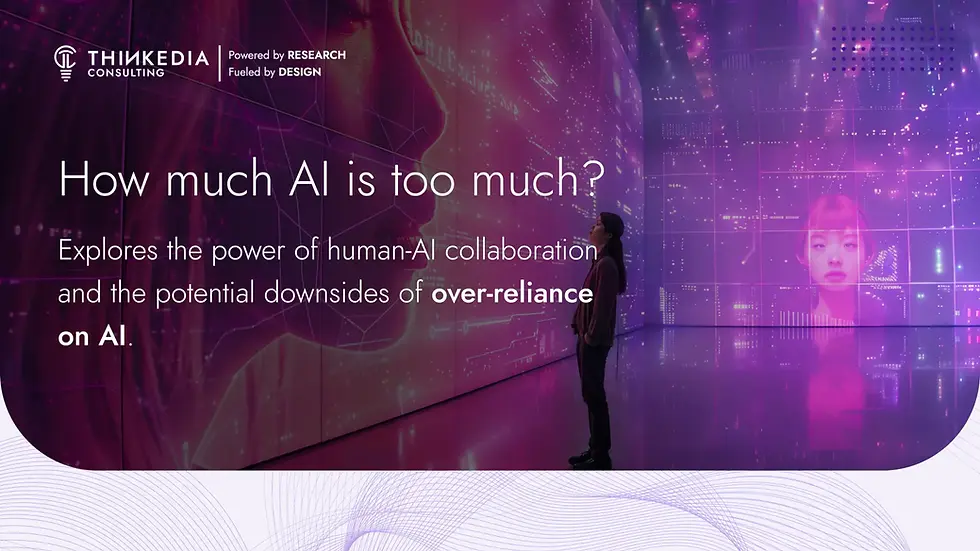
Feeling lost in the robot takeover headlines?
Don't worry, the future isn't about humans vs. machines! It's about us working together. We've all seen those "AI is going to steal your job" articles, but what if AI could actually make our jobs better?
Take Sarah, for example. She's a customer service rep who used to spend hours sifting through emails. Now, thanks to AI, she can focus on the tricky customer issues that require her unique human touch – empathy, creativity, and the ability to think outside the box. AI handles the routine stuff, freeing Sarah to use her skills where they shine.
In 2024, the trending term "Generative AI" and its predictive abilities have initiated a significant conversation regarding its influence. This has created a sense of urgency for organizations to take the lead and integrate AI into their fundamental and customer-oriented operations.
According to the CompTIA IT Industry Outlook 2024 report:
22% of firms are aggressively pursuing the integration of AI across a wide variety of technology products and business workflows.
33% of firms are engaging in limited implementation of AI.
45% of firms are still in the exploration phase.
Although AI promises incredible advancements in efficiency, automation, and data analysis, it is important to strike a proper balance with human aspects of the interaction and recognize the unique and irreplaceable strengths of being human in the age of AI. It is essential to delve into power of human-AI synergy while also examining the potential pitfalls of overreliance on AI.
The Secret Sauce: The Magic of Human-AI Teams
Humans are not simply biological machines. We possess a unique blend of cognitive and emotional intelligence to dream up crazy ideas, solve problems on the fly, and understand each other's emotions (well, most of the time). AI, on the other hand, is a whiz at crunching data and spotting patterns. Imagine what these two could achieve if they worked together!
Here's where our true value lies:
Creativity and Problem-Solving: Humans excel at thinking outside the box, generating innovative solutions, and adapting to unforeseen circumstances. AI can analyze vast amounts of data, but it lacks the ability to truly "think creatively" and come up with groundbreaking ideas.
Emotional Intelligence: Humans have a natural capacity for empathy, understanding, and navigating social dynamics. AI can be programmed to identify emotions, but it struggles to grasp the nuances of human interaction and respond with genuine care.
Ethical Considerations and Oversight: The development and deployment of AI raise a multitude of ethical concerns. Issues like bias in algorithms and the potential misuse of AI require human judgment and oversight to ensure responsible implementation.

The Pitfalls of Going All-In on AI
While AI is a powerful tool, it's not perfect. Relying too heavily on it can backfire.
Remember that time you used an automated chat service and ended up more frustrated than before? Yeah, that.
Without the human touch, AI can struggle to understand our emotions or answer complex questions. Plus, if the data used to train AI is biased, it can perpetuate inequalities in society.
While AI offers undeniable benefits, overreliance can lead to unforeseen consequences:
Loss of Customer Trust: The customer interaction is a very sensitive process full of emotions, empathy and human to human connection. A good conversation builds trust and value. At times AI doesn't have answers to all the questions a customer might have.
Algorithmic Bias: AI algorithms are only as good as the data they are trained on. If biased data is used, the resulting AI can perpetuate existing societal inequalities. Careful monitoring and development practices are crucial to ensure fairness and inclusivity.
Loss of Critical Thinking Skills: Dependence on AI for decision-making can erode critical thinking and problem-solving abilities in humans. Maintaining a balance is key to fostering a workforce that can adapt and innovate alongside AI.
Lack of Human-Centered & Ethical Focus: AI is a tool that empowers organisations to enhance Customer Experience But the human touch remains crucial for empathy, creativity, strategic & ethical decision-making though CX Research, Strategy & Experience Design.
Finding The Golden Ratio: The Human-AI Symphony
The key is finding the sweet spot. AI should be a tool to empower humans. Critical thinking, creativity, and communication – all the things that make us uniquely human.
Here's how to achieve this optimal balance by leveraging both human and AI strengths to create a brighter tomorrow.
Focus on AI as an enabler tool to augment human capabilities, not replace them.
Invest in education and training to equip the workforce with the skills needed to thrive in the AI age.
Prioritize ethical considerations in AI development and implementation. This encompasses ensuring transparency, mitigating algorithmic bias, and avoiding the misuse of AI for harmful purposes.
Setting up the governance rules : User experience experts acts as a human advocate to help.
Making AI Human-Friendly : How User Experience (UX) Services & Experts contribute in the Human-AI Symphony
This is where UX experts come in like the conductors of the human-AI symphony, making sure everyone plays their part. They research how humans interact with AI, then design interfaces that are clear, user-friendly, and build trust. Think of them as the bridge between the technical and the human, ensuring AI feels approachable and helpful, not intimidating.
In this delicate dance between humans and AI, User Experience (UX) services and experts play a critical role in ensuring a successful and harmonious collaboration. Here's how:
Understanding User's Human Needs: UX experts conduct user research to understand how humans will interact with AI-powered systems. This ensures the AI is designed to be intuitive, user-friendly, and addresses the specific needs and expectations of the target audience.
Designing for Seamless Interaction: UX professionals design user interfaces that bridge the gap between humans and AI. They create interfaces that are clear, concise, and provide users with the necessary feedback and control over their interactions with AI.
Building Trust and Transparency: UX specialists help to build trust between humans and AI by ensuring clear communication and transparency within the system. Users should understand the capabilities and limitations of the AI, and feel comfortable interacting with it.
Prioritizing Human-Centered Design: Ultimately, UX services ensure that AI is designed with the human user at the center. The focus is on creating a positive, enriching, and ultimately beneficial experience for humans when interacting with AI.
"User Experience experts are the conductors of the human-AI symphony. They ensure user needs are heard, the interaction is smooth, trust is built, and ultimately, the entire experience is designed with the human at the center."
The increasing presence of Artificial Intelligence (AI) necessitates careful consideration of how this powerful technology is developed and used. To ensure AI serves humanity for good, robust governance frameworks are essential. Here's a breakdown of key steps in setting up effective AI governance:
1. Define Your Goals, Needs and Values of Incorporating AI
3. Establish Risk Assessment and Mitigation Strategies for data bias and misuse:
4. Prioritize Transparency and Explainability:
5. Foster a Culture of Continuous Discovery
6. Implement Monitoring and Auditing Mechanisms of AI Systems in accordance with ethical guidelines
7. Promote Public Adoption and trust
8. Leverage Existing Frameworks and Guidelines
Weaving UX considerations into the fabric of AI development, deployment & governance isn't just about user satisfaction; it's a crucial step towards building a responsible and ethical future for AI. By establishing a robust AI governance framework tailored to your specific needs, you can foster responsible development, promote trust, and ensure AI serves humanity's best interests. Remember, AI governance is a living document, requiring continuous evaluation and adaptation to keep pace with this rapidly evolving technology.
Human & AI represent a powerful partnership with the potential to unlock incredible progress and improve our lives. By acknowledging the unique strengths of both humans and AI, we can pave the way for a future where humans and machines work in harmony, creating a more innovative, equitable, and prosperous world.
Comments